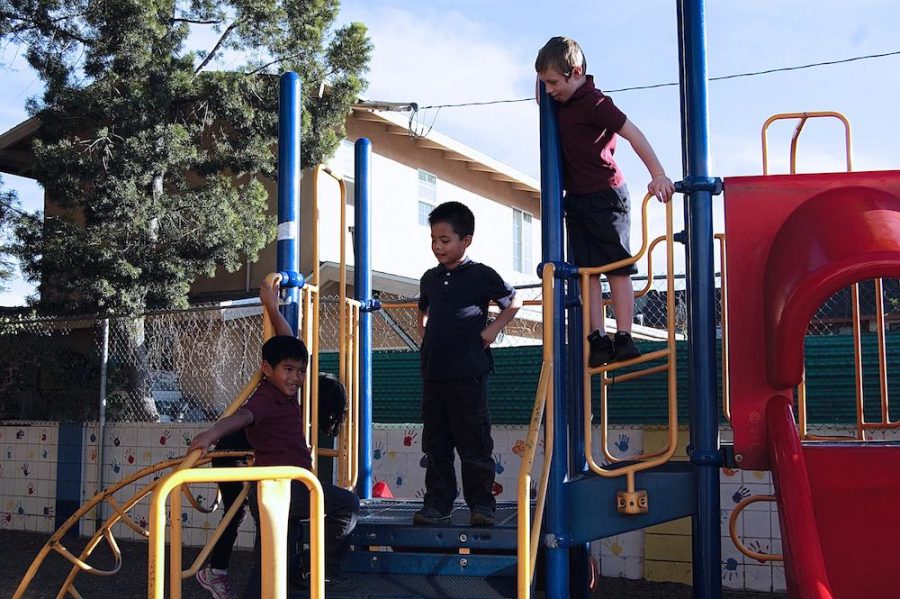(March 8, 2012)– As the sun began to set on March 3, people started milling into the upper parking lot of La Salle High School in Pasadena, taking in the view of stacked cardboard boxes and Christmas lights strung from the top of the fence. Among the hundreds were 11 Clark students who found out about the annual event through Key Club. They registered and read over the agenda, while passersby in cars read over posters taped to the fence saying “100 million Homeless” and “1 billion in urban slums.” Complete strangers formed a large circle while waiting for seven o’clock—when the event would start—and played a game called Ninja. The event had not started yet and the goal of bringing people closer together was already underway. Once most people arrived, coordinator James Burke played the video of last year’s Shantytown event and explained in depth the goal of the event: to raise $10,000 to fully fund one Brush With Kindness project and renovate a substandard home for a family. Each participant’s donation would go towards that goal. Junior Mary Chakerian didn’t attend the event for the sake of community service hours, but rather because she believes it is a better use of one’s time to help someone in need than to waste it doing other inconsequential tasks. She first felt nervous at first, but that immediately turned to excitement after the icebreakers and after she purchased a torta from the adjacent food trucks. “This is an amazing experience. During the introduction I didn’t realize that the lady sitting next to me was going to be changing my life in a few minutes,” said Chakerian about guest speaker Sandra Crockett. A video on homelessness, followed by Crockett’s speech, shed light on the way Habitat for Humanity operates and what the outcomes are like. Crockett left home at 16, was a victim of domestic violence, and found herself and her three children in a run-down apartment where they lived for six years. She applied to be a recipient of one of the 11 homes Habitat for Humanity was going to construct, thinking she would never be chosen. She was, and on Christmas Day. She was not given a handout, however, and had to work to build her home alongside volunteers as well as attend fundraisers for four to five hours at a time. On what was a somber, hopeful and humbling moment for many, the shanty building began and turned into the highlight of the night for many attendees. With the glow from the Christmas lights on their faces, more than 200 young adults relived their childhood days as they tore apart, taped, cut, and literally built a home out of cardboard in which they would sleep that night. Judges went around and groups presented their shanties. First, second, and third place were awarded to both the girls and the boys (as they slept in separate shanties), first place receiving a prize. “It’s looking at life through someone’s house. It may be cardboard, but that’s a home for a lot of people,” said Chakerian. The majority of participants were not as jovial on the morning of March 4 as they had been the night before, especially those whose shanties had not remained fully intact through the night. There were no footballs and volleyballs being thrown, no dancing, and no guitar-playing (aside from one teenage boy) as there had been just hours earlier. After the Youth United Leadership Committee, comprised of the teenage coordinators of the event, was recognized and evaluation sheets were filled out, most sat around munching on granola bars and half-heartedly cleaning up their messes. “I felt tired and cold and cranky. Also kind of confused because I didn’t know where I was and then I realized I was sleeping outside,” said sophomore Anastasia Pinal. “Shantytown made me feel empathy for people without homes because when I got home I was so happy to have my bed back.” The goal had been achieved. If people had slept well and felt energized and rested in the morning, they would not have understood the point of the event. In simulating what homeless people feel on a daily basis—without the basic commodities participants had—they more or less grasped the difficulty and physical as well as mental exertion it takes to withstand the elements. The hope is that they will take that understanding and put it to good use by doing their part and participating in future build-days and fundraisers to alleviate the conditions of poverty housing.
Categories:
Shantytown touches hearts
March 8, 2012
More to Discover








